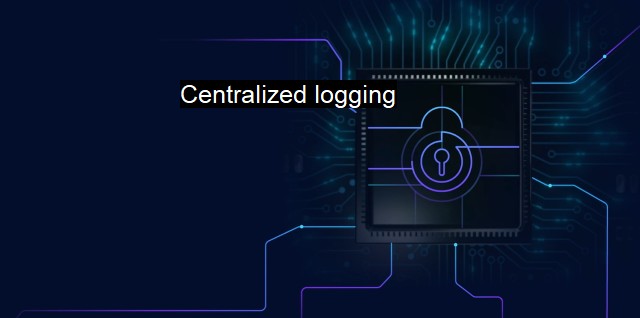What is Centralized logging?
Streamlining Cybersecurity with Centralized Logging: A Comprehensive Guide to Effective Threat Management and Incident Detection
Centralized logging is a crucial element. It refers to gathering logs from multiple sources, such as web servers, databases, mobile and web applications, among others, and storing them in one central location. By doing this, organizations can increase their ability to analyze vast amounts of data, detect abnormalities, and respond in a timely manner to potential threats or actual cyber-attacks. centralized logging offers organizations a clearer snapshot of their server environment and its activities, which can subsequently foster more robust cybersecurity measures.Given the growing complex networking environments, with numerous components constantly communicating with each other and the prevalence of sophisticated cyber threats, having a centralized logging system promotes efficiency and cyber-risks limitation. A single server can generate numerous logs every day. Multiply that by numerous servers and the complexities of storing and reviewing all of those logs becomes essentially unsustainable; hence, the importance of centralized logging. having decentralized logs leaves enterprises open to potential security breaches as attackers might attempt to change or delete logs to hide their activities.
Primarily, centralized logging enriches cybersecurity by improving threat detection, a feature particularly paramount to the antivirus functionality. It allows organizations to leverage large quantities of data to analyze and identify patterns, thereby improving their threat intelligence capabilities. This, in turn, enables them to better formulate responses to potential or current threats. With efficient log management, vulnerabilities can be caught in real-time and taken care of before they lead to broader issues like data breaches or hardware damage.
Secondly, a centralized logging system supports incident response and forensics activities. When a data breach occurs, having all logs centralized boosts the process of understanding the attack sequence. By accessing a central location where logs have been kept, it becomes easier to locate and inspect affected systems, and consequently, identify the attack vector and the system gaps the hacker exploited. This provides key insights that can guide countermeasures, preventing a reiteration of the incident.
Within the context of regulations and compliance requirements, like the General Data Protection Regulation (GDPR), organizations are expected to maintain detailed logs which track access and changes made to data systems. A centralized logging system supports achieving these compliance levels by providing all logs in one location that auditors can conveniently access and review.
From a scalability and business growth perspective, centralized logging systems offer a more streamlined way to manage new implementations or expansions. When new systems or updates are implemented, the centralized logging mechanism makes the alignment of these components with the existing ones more seamless. It becomes significantly easier to add more networks, systems, and applications into the mix, without distorting the telemetry structure.
Despite the list of merits, some challenges pervade. They include the mismanagement of time zones, which might cause discrepancies in the analysis of log files obtained from systems located in different time zones, and the risk of all logs being targeted since they are assembled in a single location.
With a correctly implemented centralized logging system, businesses can significantly enhance their cybersecurity landscape, embracing vulnerability and compliancy requirements, while allowing for manageable growth and development. Logging is a significant part of network transparency that enables decision-makers to track actions on servers and devices, instituting preemptive measures to guard against threat actors. Understanding this core aspect of cybersecurity ultimately helps organizations in maintaining secure and reliable operation levels.

Centralized logging FAQs
What is centralized logging?
Centralized logging is a method of collecting and storing log data from multiple sources in a central location. It allows security teams to aggregate and analyze log data from various security tools, including antivirus solutions, to identify and respond to security incidents more effectively.Which antivirus solutions support centralized logging?
Most antivirus solutions support centralized logging. However, you should ensure that the antivirus solution you plan to use has built-in support for exporting log data to centralized logging platforms like Splunk, ELK Stack, Graylog, etc.What are the benefits of implementing centralized logging for antivirus solutions?
Centralized logging provides several benefits for antivirus solutions, such as: 1. Reducing the time and effort required to identify and respond to security incidents. 2. Enabling security teams to monitor and analyze log data from multiple sources in real-time. 3. Providing a more comprehensive view of the organization's security posture. 4. Improving compliance with regulatory requirements.How can I ensure the security of my centralized logging infrastructure?
To ensure the security of your centralized logging infrastructure, you should follow the best practices, such as: 1. Implementing secure communication protocols between the antivirus solution and the centralized logging platform. 2. Configuring access controls to restrict access to log data to authorized personnel only. 3. Implementing secure storage mechanisms to protect logs from unauthorized access or tampering. 4. Regularly monitoring and auditing centralized logging systems to detect and respond to security incidents.| | A | | | B | | | C | | | D | | | E | | | F | | | G | | | H | | | I | | | J | | | K | | | L | | | M | |
| | N | | | O | | | P | | | Q | | | R | | | S | | | T | | | U | | | V | | | W | | | X | | | Y | | | Z | |
| | 1 | | | 2 | | | 3 | | | 4 | | | 7 | | | 8 | | |||||||